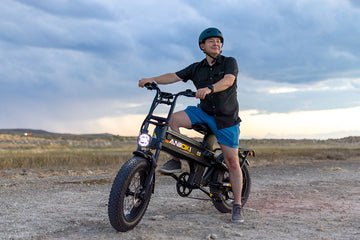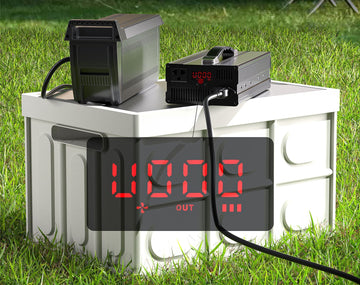Electric bikes have revolutionized urban commuting, offering an efficient and eco-friendly alternative to traditional bicycles. The heart of these innovative machines lies in their sophisticated technology, including the controller, battery, electrical system, and motor.
The ebike controller, in particular, plays a pivotal role. Without it, the motor remains dormant, rendering the bike immobile. But what if your controller malfunctions? How can you diagnose the issue? Is repair or replacement the solution?
In this guide, we delve into the world of ebike controllers, providing clear steps on how to test their functionality. Let's ensure your electric bike keeps you on the move. Read on to learn more.
What Is An Ebike Controller?
The ebike controller serves as the central nervous system of your electric bicycle, orchestrating its various components. Responsible for regulating the motor's speed, as well as enabling start and stop functions, it connects crucial elements like the throttle, battery, display, motor, and speed sensor.
Internally, the controller is a complex unit comprising microcontrollers, sensors, resistors, and MOSFETs. Its intricate circuitry encompasses signal processing, AD conversion, power device drivers, PWM generation, and over-current and under-voltage protection, ensuring seamless functionality.
Functions of an Ebike Controller
1. Power Regulation
The controller acts as a traffic cop for electrical current, determining how much power the motor receives. This dictates your speed and acceleration.
2. Direction Control
It manages the motor's direction, ensuring you can move forward and, in some cases, even in reverse.
3. Brake Handling
The controller interprets signals from your brake levers. When brakes are applied, it immediately cuts power to the motor, ensuring a safe and prompt stop.
4. Data Processing
It continuously processes data from various sensors like the pedal-assist sensor and throttle, adjusting the power output accordingly.
5. Error Detection
Many controllers are equipped with diagnostic capabilities. They can detect and sometimes display error codes, indicating potential issues that may require attention.
Types of Ebike Controllers
1. Brushed Controllers
Traditional and economical, these controllers use brushed motors. They're known for their simplicity and robustness.
2. Brushless Controllers
These controllers pair with brushless motors, providing greater efficiency, less maintenance, and a smoother ride. They are the most common type in modern ebikes.
3. Programmable Controllers
Advanced users often opt for programmable controllers, which allow customization of power delivery, fine-tuning the ebike to personal preferences.
How to Test an Ebike Controller at Home
Basic electric bike troubleshooting is a skill every biker should have. For example, Learning how to test an ebike controller at home can save you from grounding your bike. There are two ways to test an ebike controller:
1. Using a Multimeter

This method requires a bit more technical prowess, necessitating a multimeter, controller, and battery. Follow these steps to test your ebike controller using a multimeter:
Step 1: Connect your controller to the battery.
Step 2: Set the multimeter reading based on what you're testing: resistance or continuity.
Step 3: For continuity testing, set your multimeter to continuum. Connect the black cable to the battery's negative terminal.
Step 4: Test each line emanating from the controller. A beep indicates a short in the line.
Step 5: Switch your multimeter to resistance mode to check for resistance.
Step 6: Repeat the continuity testing procedure, but this time, read the digits on your multimeter. If it's below eight kilohms, there may be damage or a malfunction.
2. Using an Ebike Tester
Using an ebike tester offers a broader diagnostic scope, allowing you to test not just the controller, but all facets of your bike. These testers come in various models, each serving the same purpose. Here's how to test your ebike controller with one:
Step 1: Detach the ebike controller from the bike.
Step 2: Disconnect the throttle from the bike and attach it to the ebike controller. This confirms if the controller is receiving signals from the throttle.
Step 3: Connect the ebike tester to the controller.
Step 4: Power on the bike tester.
Step 5: Activate the throttle and observe the signal on the controller.
If the tester light flashes, all systems are go. However, if only the middle light flashes, your controller may be experiencing issues.
By mastering these testing methods, you'll not only enhance your biking experience but also ensure that you're well-prepared to address any potential hiccups in your electric bike's performance.
Frequently Asked Questions for Ebike Controller
Why Does My Ebike Keep Cutting Out?
Ebike cutouts can stem from a variety of issues, including battery depletion, loose connections, low battery charge, and motor wear. However, the main culprit is often inadequate power or voltage reaching the motor.
Choosing the Right Controller for Your Bike?
Ensure the controller's voltage matches that of your motor, and that the power rating aligns as well. If buying a controller for a specific motor, double-check both the power and voltage compatibility.
Lifespan of an Ebike Controller?
On average, an ebike controller should last about 3-4 years, mirroring the lifespan of the motor and battery. Use a multimeter to check the voltage passing through the terminals to determine if replacement is needed.
Resetting Your Ebike Controller?
Though the process may vary by manufacturer, here's a general guide:
- Turn off the ebike and disconnect the battery.
- Wait at least 10 seconds before reconnecting the battery.
- Turn on the ebike to check if the controller has been successfully reset.
Signs of a Faulty Ebike Controller?
Watch out for these indicators of a potential issue:
- Motor malfunctions
- Display or lights not functioning
- Difficulty charging the battery
- Excessive heat from the controller
Conclusion
To test your ebike controller at home, you have two reliable options: a multimeter or an ebike tester. If you choose to use a multimeter, follow these steps:
Resistance Test: Measure the resistance, and be alert for readings below eight kilohms, as this indicates potential damage.
Continuity Test: Listen for a beep, which signals a potential short.
Observe the lights on the tester:
- If the middle light is on, it may indicate a controller issue.
- If all five lights are flashing, your controller is likely functioning correctly.
With these skills in hand, you can now confidently test your ebike controller at home. Ride on!






